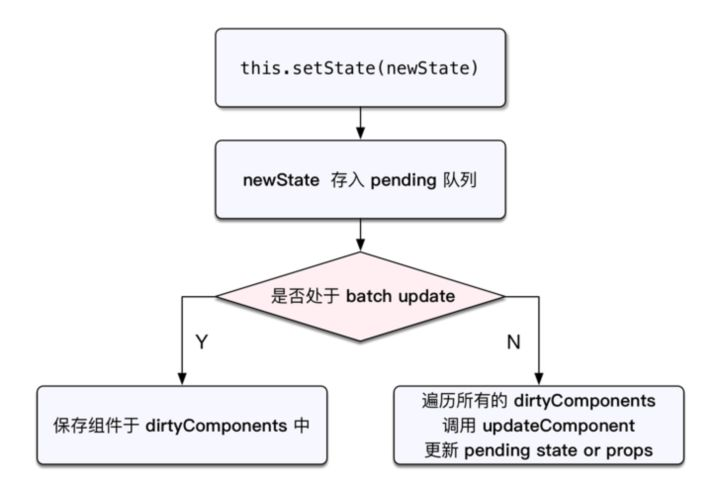关于setState的一些记录
在看React的官方文档的时候, 发现了这么一句话,State Updates May Be Asynchronous,于是查询了一波相关的资料, 最后归纳成以下3个问题
- setState为什么要异步更新,它是怎么做的?
- setState什么时候会异步更新, 什么时候会同步更新?
- 既然setState需要异步更新, 为什么不让用户可以同步读到state的新值,但更新仍然是异步?
常见场景下的异步更新
以下是官方文档的一个例子, 调用了3次incrementCount方法, 期望this.state.count的值是3, 但最后却是1
incrementCount() { this.setState({count: this.state.count + 1}); } handleSomething() { // Let's say `this.state.count` starts at 0. this.incrementCount(); this.incrementCount(); this.incrementCount(); // When React re-renders the component, `this.state.count` will be 1, but you expected 3. // This is because `incrementCount()` function above reads from `this.state.count`, // but React doesn't update `this.state.count` until the component is re-rendered. // So `incrementCount()` ends up reading `this.state.count` as 0 every time, and sets it to 1. // The fix is described below! }
那么就可以引出第一个问题
setState为什么要异步更新,它是怎么做的?
深入源码你会发现:(引用程墨老师的setState何时同步更新状态)
在 React 的 setState 函数实现中,会根据一个变量 isBatchingUpdates 判断是直接更新 this.state 还是放到队列中回头再说, 而 isBatchingUpdates 默认是 false,也就表示 setState 会同步更新 this.state, 但是,有一个函数 batchedUpdates,这个函数会把 isBatchingUpdates 修改为 true, 而当 React 在调用事件处理函数之前就会调用这个 batchedUpdates,造成的后果,就是由 React 控制的事件处理过程 setState 不会同步更新 this.state。
然后我在网上引用了这张图(侵删)

从结论和图都可以得出, setState是一个batching的过程, React官方认为, setState会导致re-rederning, 而re-rederning的代价是昂贵的, 所以他们会尽可能的把多次操作合并成一次提交。以下这段话是Dan在Issue中的回答:

中心意思大概就是:
同步更新setState并re-rendering的话在大部分情况下是无益的, 采用batching会有利于性能的提升, 例如当我们在浏览器插入一个点击事件时,父子组件都调用了setState,在batching的情况下, 我们就不需要re-render两次孩子组件,并且在退出事件之前re-render一次即可。
那么如果我们想立即读取state的值, 其实还有一个方法, 如下代码:
因为当传入的是一个函数时,state读取的是pending队列中state的值
incrementCount() { this.setState((state) => { // Important: read `state` instead of `this.state` when updating. return {count: state.count + 1} }); } handleSomething() { // Let's say `this.state.count` starts at 0. this.incrementCount(); this.incrementCount(); this.incrementCount(); // If you read `this.state.count` now, it would still be 0. // But when React re-renders the component, it will be 3. }
当然, 仔细看React文档的话, 可以发现, State Updates May Be Asynchronou里面有一个may的字眼,也就是可能是异步更新, 因而引出第二个问题
setState什么时候会异步更新, 什么时候会同步更新?
其实从第一个问题中我们就知道,React是根据isBatchingUpdates来合并更新的, 那么当调用setState的方法或者函数不是由React控制的话, setState自然就是同步更新了。
简单的举下例子:
- 如componentDidMount等生命周期以及React的事件即为异步更新,这里不显示具体代码。
- 如自定义的浏览器事件,setTimeout,setInterval等脱离React控制的方法, 即为同步更新, 如下(引用程墨老师的setState何时同步更新状态)
componentDidMount() { document.querySelector('#btn-raw').addEventListener('click', this.onClick); } onClick() { this.setState({count: this.state.count + 1}); console.log('# this.state', this.state); } // ...... render() { console.log('#enter render'); return ( <div> <div>{this.state.count} <button id="btn-raw">Increment Raw</button> </div> </div> ) }
有的人也会想能不能React依然合并更新, 但用户可以同步读取this.state的值, 这个问题在React的一个Issue上有提到, 也是我们的第三个问题
既然setState需要异步更新, 为什么不让用户可以同步读到state的新值,但更新仍然是异步?
这个问题可以直接在Dan的回答中得到:
This is because, in the model you proposed, this.state would be flushed immediately but this.props wouldn’t. And we can’t immediately flush this.props without re-rendering the parent, which means we would have to give up on batching (which, depending on the case, can degrade the performance very significantly).
大概意思就是说:
如果在应用中,this.state的值是同步,但是this.props却不是同步的。因为props只有当re-rendering父组件后才传给子组件,那么如果要props变成同步的, 就需要放弃batching。 但是batching不能放弃。



